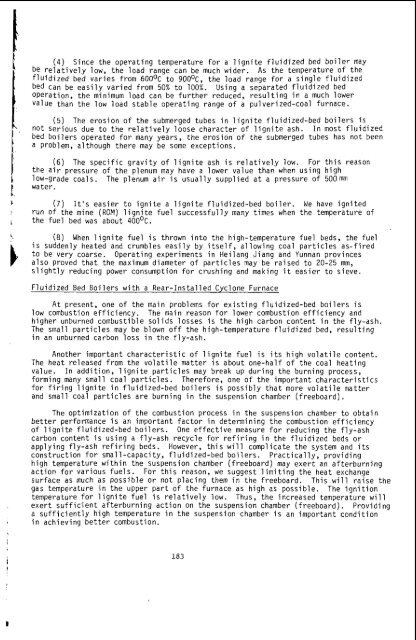the coking properties of coal at elevated pressures. - Argonne ...
the coking properties of coal at elevated pressures. - Argonne ...
the coking properties of coal at elevated pressures. - Argonne ...
You also want an ePaper? Increase the reach of your titles
YUMPU automatically turns print PDFs into web optimized ePapers that Google loves.
(4) Since <strong>the</strong> oper<strong>at</strong>ing temper<strong>at</strong>ure for a lignite fluidized bed boiler may<br />
be rel<strong>at</strong>ively low, <strong>the</strong> load range can be much wider. As <strong>the</strong> temper<strong>at</strong>ure <strong>of</strong> <strong>the</strong><br />
fluidized bed varies from 6OO0C to 900°C, <strong>the</strong> load range for a single fluidized<br />
bed can be easily varied from 50% to 100%.<br />
Using a separ<strong>at</strong>ed fluidized bed<br />
oper<strong>at</strong>ion, <strong>the</strong> minimum load can be fur<strong>the</strong>r reduced, resulting in a much lower<br />
value than <strong>the</strong> low load stable oper<strong>at</strong>ing range <strong>of</strong> a pulverized-<strong>coal</strong> furnace.<br />
(5) The erosion <strong>of</strong> <strong>the</strong> submerged tubes in lignite fluidized-bed boilers is<br />
not serious due to <strong>the</strong> rel<strong>at</strong>ively loose character <strong>of</strong> lignite ash. In most fluidized<br />
bed boilers oper<strong>at</strong>ed for many years, <strong>the</strong> erosion <strong>of</strong> <strong>the</strong> submerged tubes has not been<br />
a problem, although <strong>the</strong>re may be some exceptions.<br />
(6) The specific gravity <strong>of</strong> lignite ash is rel<strong>at</strong>ively low. For this reason<br />
<strong>the</strong> air pressure <strong>of</strong> <strong>the</strong> plenum may have a lower value than when using high<br />
low-grade <strong>coal</strong>s. The plenum air is usually supplied <strong>at</strong> a pressure <strong>of</strong> 500mm<br />
w<strong>at</strong>er.<br />
(7) It's easier to ignite a lignite fluidized-bed boiler. We have ignited<br />
run <strong>of</strong> <strong>the</strong> mine (ROM) lignite fuel successfully many times when <strong>the</strong> temper<strong>at</strong>ure <strong>of</strong><br />
<strong>the</strong> fuel bed was about 40OoC.<br />
(8) When lignite fuel is thrown into <strong>the</strong> high-temper<strong>at</strong>ure fuel beds, <strong>the</strong> fuel<br />
is suddenly he<strong>at</strong>ed and crumbles easily by itself, allowing <strong>coal</strong> particles as-fired<br />
to be very coarse. Oper<strong>at</strong>ing experiments in Heilang Jiang and Yunnan provinces<br />
also proved th<strong>at</strong> <strong>the</strong> maximum diameter <strong>of</strong> particles may be raised to 20-25 mm,<br />
slightly reducing power consumption for crushing and making it easier to sieve.<br />
Fluidized Bed Boilers with a Rear-Installed Cyclone Furnace<br />
At present, one <strong>of</strong> <strong>the</strong> main problems for existing fluidized-bed boilers is<br />
low combustion efficiency. The main reason for lower combustion efficiency and<br />
higher unburned combustible solids losses is <strong>the</strong> high carbon content in <strong>the</strong> fly-ash.<br />
The small particles may be blown <strong>of</strong>f <strong>the</strong> high-temper<strong>at</strong>ure fluidized bed, resulting<br />
in an unburned carbon loss in <strong>the</strong> fly-ash.<br />
Ano<strong>the</strong>r important characteristic <strong>of</strong> lignite fuel is its high vol<strong>at</strong>ile content.<br />
The he<strong>at</strong> released from <strong>the</strong> vol<strong>at</strong>ile m<strong>at</strong>ter is about one-half <strong>of</strong> <strong>the</strong> <strong>coal</strong> he<strong>at</strong>ing<br />
value. In addition, lignite particles may break up during <strong>the</strong> burning process,<br />
forming many small <strong>coal</strong> particles. Therefore, one <strong>of</strong> <strong>the</strong> important characteristics<br />
for firing lignite in fluidized-bed boilers is possibly th<strong>at</strong> more vol<strong>at</strong>ile m<strong>at</strong>ter<br />
and small <strong>coal</strong> particles are burning in <strong>the</strong> suspension chamber (freeboard).<br />
The optimiz<strong>at</strong>ion <strong>of</strong> <strong>the</strong> combustion process in <strong>the</strong> suspension chamber to obtain<br />
better performance is an important factor in determining <strong>the</strong> combustion efficiency<br />
<strong>of</strong> lignite fluidized-bed boilers. One effective measure for reducing <strong>the</strong> fly-ash<br />
carbon content is using a fly-ash recycle for refiring in <strong>the</strong> fluidized beds or<br />
applying fly-ash refiring beds. However, this will complic<strong>at</strong>e <strong>the</strong> system and its<br />
construction for small-capacity, fluidized-bed boilers. Practically, providing<br />
high temper<strong>at</strong>ure within <strong>the</strong> suspension chamber (freeboard) may exert an afterburning<br />
actior! for various fuels. For this reason, we suggest limiting <strong>the</strong> he<strong>at</strong> exchange<br />
surface as much as possible or not placing <strong>the</strong>m in <strong>the</strong> freeboard. This will raise <strong>the</strong><br />
gas temper<strong>at</strong>ure in <strong>the</strong> upper part <strong>of</strong> <strong>the</strong> furnace as high as possible. The ignition<br />
temper<strong>at</strong>ure for lignite fuel is rel<strong>at</strong>ively low. Thus, <strong>the</strong> increased temper<strong>at</strong>ure will<br />
exert sufficient afterburning action on <strong>the</strong> suspension chamber (freeboard).<br />
Providing<br />
a sufficiently high temper<strong>at</strong>ure in <strong>the</strong> suspension chamber is an important condition<br />
in achieving better combustion.<br />
183

















